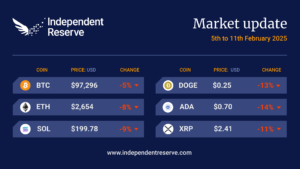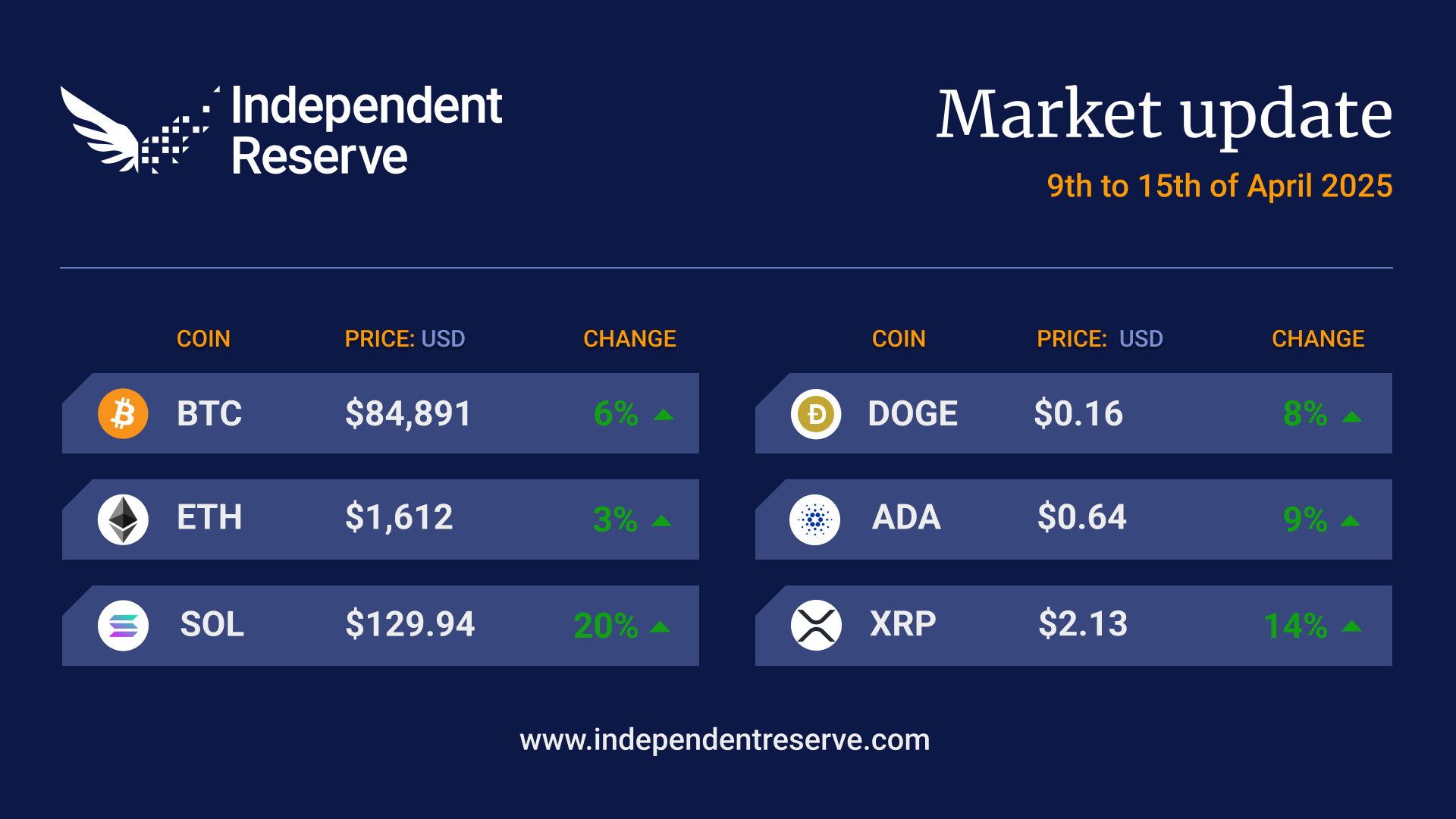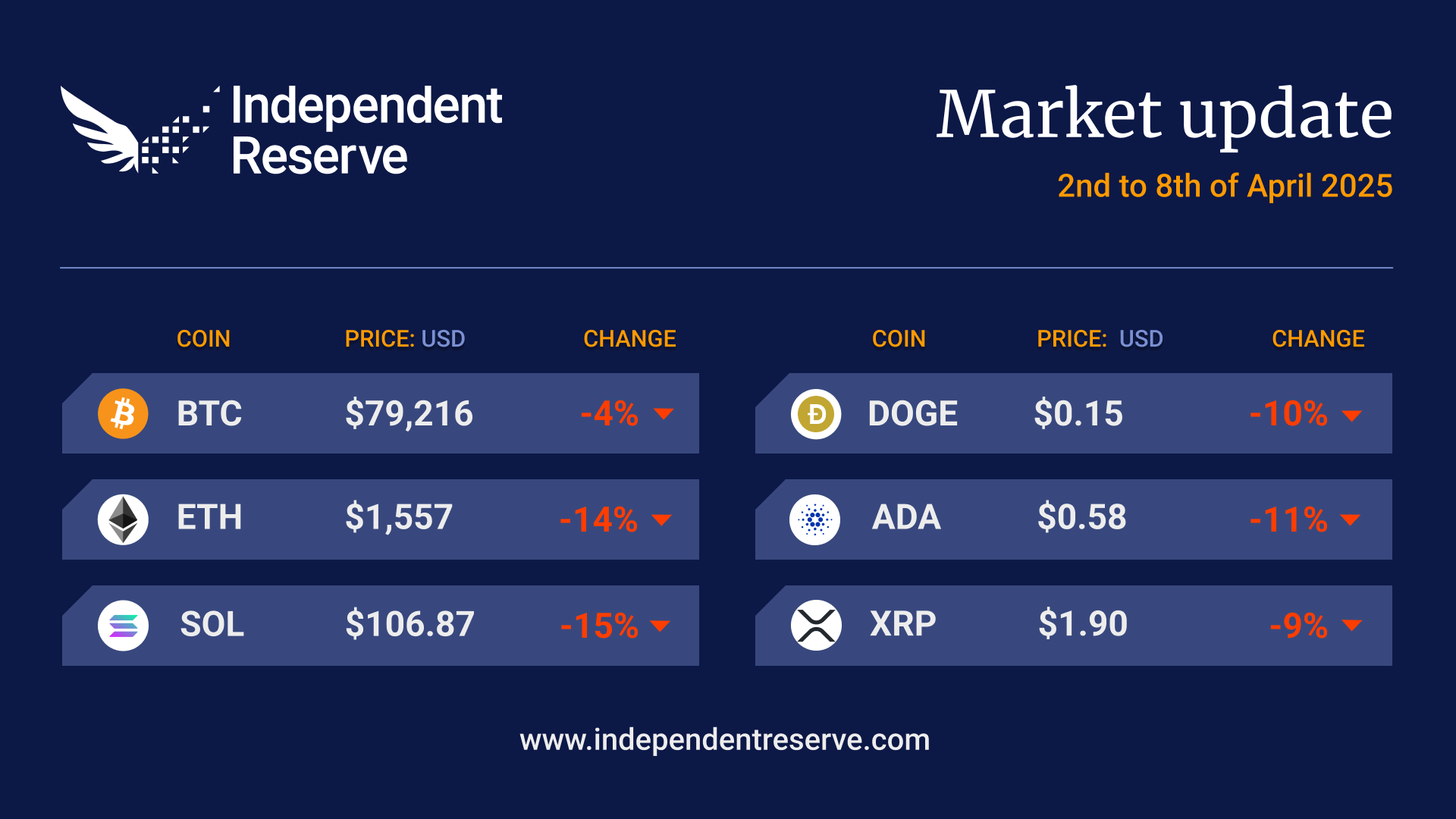In Markets
Bitcoin is still worth almost US$100K but the bearishness on social media might have you convinced the cycle is over. President Donald Trump’s tariff war — currently aimed at China, worldwide steel, and potentially the EU — and disappointing earnings reports from Nvidia, Meta and Microsoft are weighing on prices. About 70% of crypto assets traded on Binance are now below their pre-election prices, and there are now 11 million coins on Coinmarketcap, which is hampering any chance of an altseason. “Retail sentiment is the worst it’s been in years, while professional investors are extraordinarily bullish. It’s like living in two completely separate worlds,” observed Matt Hougan, Bitwise CIO. Bitcoin finishes the week down 5% to trade at A$155,024 (US$97,296), with Ethereum down 8% to trade around A$4,228 (US$2,654). XRP lost 11%, Solana fell 9%, while Dogecoin (-13%), Cardano (-14%) and Shiba Inu (-3.8%) were also down. The Crypto Fear and Greed Index is at 43, or Fear.

Market Overview
- Rangebound week: Following last week’s rapid liquidation wicks, markets were in more of a consolidatory phase as BTC/USD ranged from 102,000 at the start of the week to lows of 94,900 on Independent Reserve before finding bids and trading back up to 98,000.
- Trade war fears: Market movements were largely influenced by tariff announcements over the week. Trump announced a 25% tariff on steel and aluminium imports, an increase from the earlier 10% tariff. Earlier this week, China had responded with a 15% tariff on coal and liquefied natural gas products, alongside a 10% tariff on crude oil, agricultural machinery, and large-engine cars imported from the U.S. These came into effect on Monday.
- An interesting move for the week: The move came from the precious metals market; gold prices hit all-time highs, trading up to USD 2,930 per ounce. From this, it appears that Bitcoin has been trading more like a risk asset rather than a store of value, as evidenced by its lower correlation with gold vis-à-vis its correlation with the S&P 500.
- Altcoin exchange-traded funds (ETFs): As of right now, only BTC and ETH have spot ETFs in the US, but this may soon change as there are pending proposals for Litecoin, XRP, Solana, as well as Dogecoin. According to Bloomberg Analysts, the probabilities of these getting approved in 2025 are as follows:
- Litecoin: 90%
- Dogecoin: 75%
- Solana: 70%
- XRP: 65%
Separately, NYSE Arca, on behalf of crypto asset manager Grayscale, has also filed to launch a spot Cardano ETF.
OTC desk activity:
- Huge volume demand for stablecoins on the OTC desk, specifically with interest in purchasing USDT despite it trading at a premium.
- Smaller off-ramping and profit-taking flows amidst fear of the effects of the trade war.
Key Economic Calendar Events (AEDT):
- Wednesday, February 12, 2:00 a.m.: Fed Chairman Powell Testimony
- Thursday, February 13, 12:30 a.m.: US Core Inflation Rate YoY (Consensus: 3.1%)
- Thursday, February 13, 2:00 a.m.: Fed Chairman Powell Testimony, Part 2
- Friday, February 14, 12:30 a.m.: U.S. PPI Month on Month (Consensus: 0.3%)
For any further information, please feel free to reach out.
In Headlines
Trump’s new Bitcoin ETFs
Having launched a DeFi project, two memecoins and a bunch of NFTs, Trump now wants to launch his own Bitcoin ETFs. Truth.fi, the new financial arm of Trump Media, hopes to launch six new ETFs, two of which are Bitcoin-related: the Truth.Fi Bitcoin Plus ETF and the Truth.Fi Bitcoin Plus SMA. Truth.fi only recently launched, saying it will invest in crypto and Bitcoin.
ETFs and the regulators
In other ETF news, the SEC has kicked the can down the road for the approval of options for BlackRock’s iShare’s Ethereum Trust. It will now make a decision by April. “I wouldn’t read too much into it, can’t imagine they don’t get approved eventually,” said Bloomberg senior ETF analyst Eric Balchunas. The Bloomberg boys have also just put out their altcoin ETF approval odds, which has Litecoin at a 90% chance of approval this year, Dogecoin at 75%, Solana at 70% and XRP at 65%. Meanwhile, Cboe Exchange has submitted 19b-4 filings for XRP ETFS from Canary Capital, WisdomTree, 21Shares and Bitwise. The SEC also “acknowledged” an application from Grayscale to convert its Solana Trust into an ETF. This is significant, as six weeks ago former chair Gary Gensler told CBOE exchange to withdraw its Solana ETF application entirely.
Everybody is short ETH
Short positions in Ethereum have risen more than 500% since the election in November and surged 40% in the past week. “Never in history have Wall Street hedge funds been so short of Ethereum, and it’s not even close,” said the Kobeissi Letter in a post on X. Ethereum has been underperforming Bitcoin “largely due to this extreme positioning.” However, that also lays the ground for a potential “short squeeze” when the price increases rapidly as short sellers buy Ether to avoid greater losses. Interestingly, however, following a sudden price fall, the Ether ETFs took in US$420.2M (A$669M) inflows last week, outperforming the Bitcoin ETFs, which took in US$203.8 million (A$324M).
22 US states vie to hold Bitcoin and crypto reserves
Utah’s Bitcoin reserve legislation passed the lower house this week, a historic first for a US state. The bill, which allows the state treasurer to put money into digital assets, passed by just three votes and still needs to pass the Senate and get approved by the Governor. Kentucky, Maryland and North Carolina have all just introduced similar efforts, making 22 states in total considering bills. At the same time, Michigan and Wisconsin have already invested parts of their retirement funds in crypto. Zero Australian states have proposals.
MicroStrategy is now Strategy
MicroStrategy has rebranded to simply Strategy and celebrated with another 7,633 Bitcoin purchase. Its fourth-quarter earnings report, however, revealed the company had posted a net loss of US$670.8M (A$1.06B). BlackRock has increased its stake in Strategy to 5%.
Stable GENIUS act
US Republican Senator Bill Hagerty has introduced stablecoin legislation called the Guiding and Establishing National Innovation for US Stablecoins — or GENIUS Act. It would require issuers to disclose monthly audited reports about their reserves, something Tether has notably failed to do up to this point. “My legislation establishes a safe and pro-growth regulatory framework that will unleash innovation and advance the President’s mission to make America the world capital of crypto,” said Hagerty. Democrat Senator Kirsten Gillibrand cosponsored the bill.
Hong Kong approves Bitcoin and Ethereum as proof of assets for investment immigration
Hong Kong has recognised cryptocurrency as proof of assets for investment immigration applications under the New Capital Investment Entrant Scheme (New CIES), marking a major policy shift. Two applicants from mainland China successfully met the HK$30 million (US$3.8 million) asset requirement—one using Bitcoin in October 2024 and the other Ethereum in February 2025. The approval process required an internal review by InvestHK, ensuring digital assets were stored in cold wallets or reputable exchanges. Traditionally, investment immigration applicants had to prove their wealth through stocks and bonds, making this a landmark moment for crypto adoption.
Ethereum supply inflates
Ethereum’s supply has been mostly deflationary since the Merge but has now ticked up by 0.003% a year. This has led to much criticism from Bitcoiners, even though the Bitcoin supply has risen by 1.428% over the same period. Ethereum’s Denun upgrade last April deliberately reduced fees to enable L2s to scale, which dramatically affected the amount of fees burned, and the upcoming Pectra hard fork scheduled for early April, will also double data blob capacity to help L2s scale. Fees will take yet another hit when Uniswap moves to L2 Unichain, says JPMorgan, in a bearish report stating that Ethereum lacks a compelling narrative in the face of competition from Bitcoin and Solana. The hopes of Ether true believers are now being pinned on MegaETH, a new Ethereum L2 targeting 100,000 TPS that is set to launch a public testnet within a month. Another L2 called Eclipse, which uses the Solana Virtual Machine, is recording 200M transactions a day (3x more than Solana) thanks to a tapper game. Another bright spot came after the gas limit on the base layer was set higher to 32M, with a max capacity of 36M, which helps scale the L1.
Until next week, happy trading!


